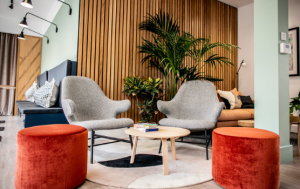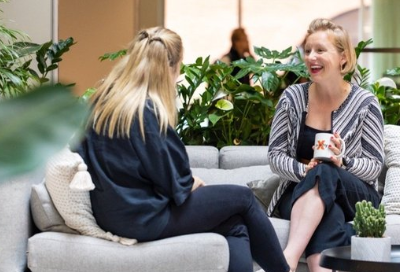By Rupert Dean, below, CEO, x+why
 It would have been hard to miss the seismic shift in the way that people work over the last few years, triggered by the pandemic and enabled by technology. This has had a lasting impact on the pattern of economic life, with the amount of time spent working from home having increased, and hybrid arrangements now very much seen as normal. The result, though, has been debate among workers over the appeal of returning to the office. Indeed, recent data from LinkedIn suggests that over a third of employees say they would resign if they were told to return to the office full time.
It would have been hard to miss the seismic shift in the way that people work over the last few years, triggered by the pandemic and enabled by technology. This has had a lasting impact on the pattern of economic life, with the amount of time spent working from home having increased, and hybrid arrangements now very much seen as normal. The result, though, has been debate among workers over the appeal of returning to the office. Indeed, recent data from LinkedIn suggests that over a third of employees say they would resign if they were told to return to the office full time.
Yet it is hard to deny that the collaborative and cohesive nature of the office still has a vital role to play when it comes to business success. So how can business leaders persuade employees of the virtues of the office, and draw their teams back together? This is where the modern workspace can step in – gone are the days that businesses could merely treat offices as somewhere that exists simply to provide desk space. I want to explore how they can become a destination that combines work wellbeing with personal and professional development, and ultimately a place that appeals to workers who have become accustomed to the benefits of home.
Some employers are perhaps guilty of thinking too much about how people will come back – which days, hours, or teams. For whilst these are obviously critical decisions to manage the functioning of the business, just as important is a focus on why people should return. When people have been benefitting from the lack of commute, and the flexibility of working from home, what is it that draws them back to an office? They will often be choosing to come into the office to achieve something specific, rather than because they are expected to. This might well include the ability to connect in-person with colleagues, a wish to learn from leaders and build their career, or the inspiration that comes from working together as a team – all of which are linked by the opportunity that a workplace offers to collaborate and build relationships.
Leaders therefore need to be looking at what the workspace can offer in a different way. It needs to be about the opportunity it provides to be more collaborative, getting face-to-face time, and creating shared experiences with teammates. Businesses need to be aiming for an office structure which provides more than just a deskspace, but instead a destination where you can strengthen culture and performance, and as a result improve productivity. This means providing spaces that allow for all elements of work life – collaborating, focusing, training, socialising and relaxing.
The design of the workplace matters. Many people will have experienced the kind of office that would fit into the category that I’d call ‘past its sell by date’. Those (often glass) open plan boxes that are lifeless and soulless, with employees crammed in, encouraged to work hard, nowhere to escape, pushed to focus on productivity only at the expense of all else. If the office is a drab maze of cubes designed decades ago, it is no surprise that workers don’t want to be in the office.
Work has changed fundamentally in the last few years, and the office needs to keep up. It sends a message the organisation cares about its employees and their experience. More relaxed and beautiful spaces that feel like home, for example, are likely to make people feel more comfortable in the workplace, and encourage more impromptu interactions with colleagues. The ‘add-ons’ that have always been thought of as ‘nice-to-haves’ should also perhaps now be seen as essential if workers are to be tempted away from home – the opportunity to exercise, outside space, comfortable furniture, good coffee. 
The social aspect of office life has always been important, but evidence shows that workers place more importance than ever on the opportunities that an office can provide for socialising. With many of us spending a part of the week working in silo from home, and able to prioritise where we spend our time, people are looking for a space where they can go to see colleagues and friends. By pursuing this approach, coming to the office can be a pleasure, or a ‘treat’ for the team during the working week, rather than something to be endured.
The modern office needs to adapt to this need, and we are seeing that flexible working spaces have the capacity and agility to close this gap between work and play. It was with this in mind that x+why recently launched the idea of our Clubspace, with the first manifestation of this at Birmingham’s 103 Colmore Row in ‘eighteen’, a space designed to encourage employee engagement and socialising.
Businesses don’t just want compliance when it comes to the return to the office – employees need to be motivated and engaged. The design of the office can definitely contribute to that, but purpose can be another factor. Commitment to sustainability and the value of doing business for good is more important than ever for many, particularly younger employees who are increasingly looking for purpose in their work. In a world where businesses are increasingly being held accountable for their impact on society and the environment, those which put a clear purpose or mission at the heart of their brand tend to have more loyal employees (and customers). Businesses should think about how to communicate the link between the importance of the office, and the overall direction and purpose of the organisation.
This might include the value of stronger relationships for feeling a greater sense of commitment to the community, and a bigger part of the mission of the business. Delivering a more sustainable workplace might well also contribute towards this. At x+why, the offices are designed to be as sustainable and green as possible, from the furniture to the living roofs and energy-efficient lighting.
Far from drudgery, the office should be seen as a place to refresh, renew and reimagine work. A place where employees can be energised and ignited by their colleagues and leaders. Businesses need to be thinking carefully about what it is that will draw their teams back, and offering the kind of workspace that fits the new way of working. When this is done with your employees front and centre of mind, the modern office can not only help to determine a positive corporate culture, but can ensure an engaged and more productive team.


